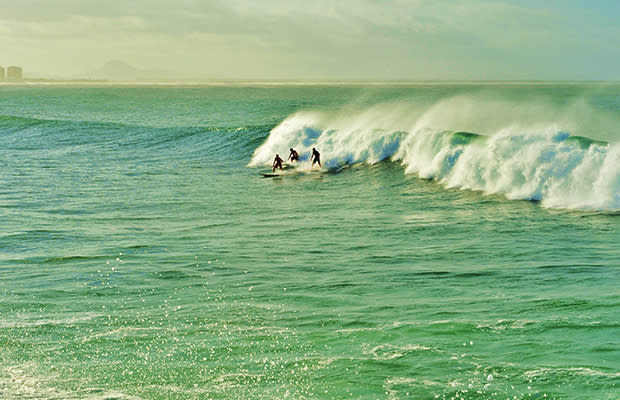
Surfers have largely eschewed the seedy reputation that’s stuck to their land-bound alterna-sport brethren. Skateboarders hang out behind the grocery store. Dirt bikers lurk around the woods. Surfers wake up early to go to the beach; even the most wholesome mom can get behind a lifestyle like that. At worst, surfers are sometimes seen as aloof Spicoli-types, perhaps a bit too laid back for their own good.
Alas, even the sunniest beach gets a dark cloud every once in a while. Menacing “surf gangs” have long played a supporting role in surf culture. Often just a close group of friends, these groups band together to enforce the infamous “locals only” policy on their favorite break. Generally, these groups are harmless, and their enforcement methods are limited to sending bad vibes your way, with perhaps a rare verbal threat. Sometimes, though, the locals take things a bit too far, and that’s when the police come in.
Here’s a brief history of surf gangs running into trouble with the law. Strap on your leash—it’s going to be a choppy ride.
If you’ve seen surf gangs in the news lately, it’s probably been related to the Luanda Bay Boys, a group of well-to-do men with a reputation for viciously guarding the breaks at Luanda Bay in Palos Verdes Estates, Calif. They’re the subject of a class action lawsuit which would force the city “to investigate and prosecute crimes committed by the group of surfers who alleged victims and witnesses have accused of bombarding outsiders with dirt clods, slashing their car tires and assaulting them in the water.” Despite dozens of complaints—one woman says she was sexually harassed and sprayed with beer—there have been no arrests at the bay in years. What’s more, as the Los Angeles Times reports, city officials appear to have dismissed the allegations: “This is an old story and one that I do not consider news or worthy of news coverage,” said Police Chief Jeff Kepley, and other officials described it as an “urban legend.” This has led many to wonder if the Bay Boys are receiving special treatment because they’re rich, older white guys.

Before the Luanda Bay Boys were in hot water, another privileged surf squad made national headlines. In 2007, pro surfer Emery Kauanui was beaten to death in front of his mother’s house by a group of surfers known as the Bird Rock Bandits. Five men were initially charged with the killing. The Bird Rock Bandits were a group of young adults from wealthy La Jolla, Calif.—Mitt Romney has a home there—with a reputation for group violence and gang admiration. Prosecutors sought to charge the men under gang legislation that would lead to harsher sentences. As TheNew York Times wrote about the case when it happened, “The California penal code defines a gang as a group of three or more people with a common name, an identifying symbol and a primary activity of committing crime.” A spokesman for the San Diego district attorney, Paul Levikow, was quoted saying that, “The law doesn’t look at socioeconomic background, it looks at actions.” A judge ultimately ruled that the group didn’t meet the legal definition of a gang, and four of the five men received plea deals for reduced sentences.
Surf gangs aren’t just a mainland phenomenon. In Hawaii, where beaches are crowded and tourists are everywhere, surf gangs have done their best to make sure that locals always have room to ride. The Wolfpak, led by Kala Alexander (who had a role in the decidedly kooky film Blue Crush), is the most notorious group on the North Shore. As one surfer put it, “It’s kind of like Mafia control in the surf.” Since 2001, they’ve sought respect using a combination of intimidation, volunteer work, and fists.

Nor is the surf gang just a recent menace. Da Hui, or the Black Shorts, have been active since forming in the ’70s in reaction to the increase in surfers from Australia and the mainland. This intense localism has been exacerbated by Hawaii’s position as a tourist hotspot; at numerous points over the last 40 years, police escorts have been required to get visiting surfers home safe.
Surf gangs might be intimidating, but don’t let this information keep you from heading out into the waves. Compared with the very real risks of drowning and spinal injuries, surf gangs are harmless. Even sharks—a statistic often compared to being struck by lightning or winning the lottery—are infinitely more threatening than your fellow humans. In the ocean, the real danger always comes from nature. That said, you should still probably think twice before cutting off a local.

